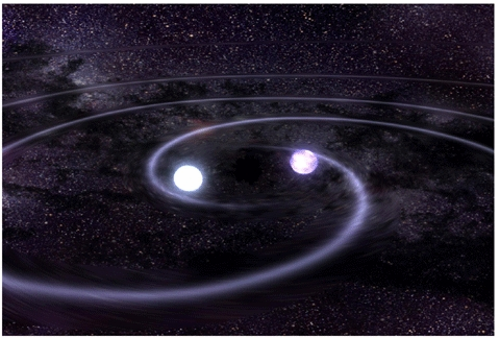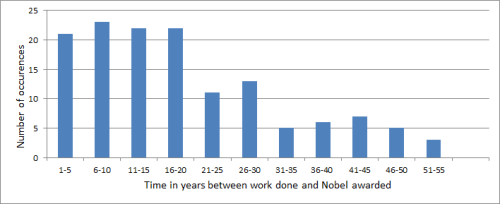
Prize winning: will the detection of gravitational waves win this year’s Nobel? (Courtesy: Caltech/MIT/LIGO Lab)
By Hamish Johnston
The first week of October is nearly upon us and the question on almost every physicist’s lips is “who will win this year’s Nobel Prize for Physics?”. The people’s favourite for 2016 seems to be the physicists who pioneered the LIGO gravitational-wave detectors. In February 2016 LIGO researchers announced that they had made the first ever detection of a gravitational wave – from two merging black holes. A few months later, a second detection was announced.
Normally, Nobel nominations are closed in January so it’s possible that LIGO missed the boat. However, both the first and second detections were actually made in 2015 – with the results subsequently published in 2016. So the LIGO pioneers could have been nominated before the deadline as the collaboration already knew it had detected gravitational waves. It’s all pure speculation, of course, as each year’s deliberations are kept top secret for 50 years.
So who could be claiming the prize for LIGO? Three people favoured by pundits are Rainer Weiss, Kip Thorne, and Ronald Drever. Drever and Weiss played crucial roles in designing and building LIGO, whereas Thorne calculated what gravitational waves would look like to the detector.
While few doubt that the trio is deserving of the prize, some commentators are calling for a collective prize given to the thousands of physicists working on LIGO. This could be a better reflection of how big physics is done, but there is no precedent for such a group prize.
The popularity of a LIGO prize got me wondering how common it was for a Nobel to be awarded just one year after a discovery. I delved into the vast archive of material on the Nobel Foundation website and produced the above histogram. It shows the frequency of time gaps between when a discovery was made and when the physics prize was awarded. I’d like to add a disclaimer that deciding exactly when the work was done is subjective, and often near impossible if the award is given for a body of work. So my data might not agree exactly with those of others, but I think it shows the general trend that most awards are given within 20 years of the work being done.
As far as I can tell, there are three instances when a physics Nobel was awarded a year after the work was done. The first was the 1957 award, which was given to Chen Ning Yang and Tsung Dao Lee for formulating a theory of parity violation for the weak interaction. The theory was proposed and verified experimentally in 1956.
The second is the 1984 prize, which went to Carlo Rubbia and Simon van der Meer for the 1983 discovery of the W and Z bosons at CERN. The final one-year gap involves the discovery in 1986 of the first high-temperature superconductor which won Georg Bednorz and Alexander Müller the 1987 Nobel.
So it is certainly possible that LIGO could feature in this year’s prize, if the nomination was made early enough.
At the other end of the scale, I reckon that there are three physics prizes that were awarded more than 50 years after the research was done. The first is the 1986 prize, which was shared by Ernst Ruska who was then 79 years old. Ruska won for his work on electron optics done in 1933. The other two were shared in 2003 by Alexei Abrikosov and Vitaly Ginzburg for independent work done in the early 1950s on superconductors and superfluids.
Personally, I think this year the award will go to Weiss, Thorne, and Drever – but I have never actually got a prediction right. If not them, I think we could see a prize for Michael Berry and Yakir Aharonov for their work on quantum topological and geometrical phases. If you’d like to get a good idea of who else could be in the running, check out this tournament-style chart that pits various superstar physicists against each other.
Please let us know who you think will win by leaving a comment below.

Michael Berry’s work on the “Berry’s phase” is more fundamental than that of Aharonov’s one for its verification. However, none of them may be the Laureates. The Ligo-team has a fair chance to be honoured along with the persons on the quantum entanglement-at-distance work. Of course, we are waiting for the word from the Delphic Oracle M. Durrani!
Dr. Johnston, we are waiting for the word on this year’s Nobel Laureate(s) from the PW-Delphic Oracle M. Durrani. Play the calm, understanding and duty-bound priest for the Earthlians!
The LIGO team’s work on the first detection of “gravitational waves” has a fair chance to be honoured with the prize this year.